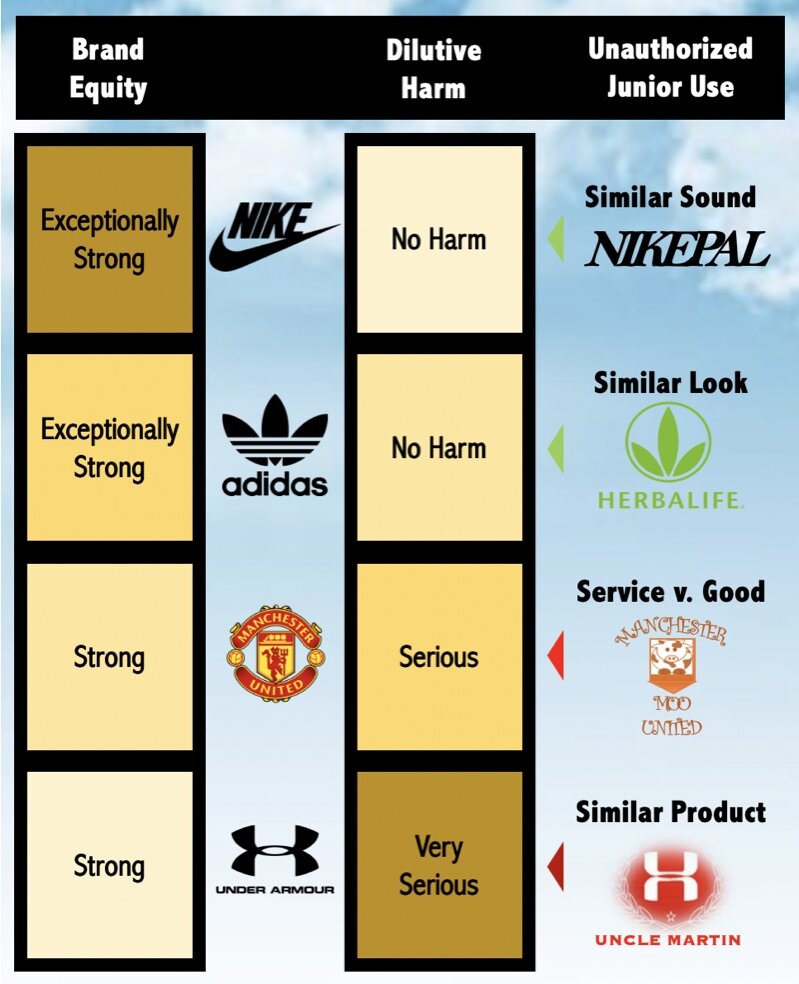Empirical Investigation of Sport Trademark Dilution Using Contingent Valuation Method
By Sungho Cho, J. Lucy Lee, June Won, and Jong Kwan (Jake) Lee (all authors are affiliated with Bowling Green State University)
Would any unauthorized use of sport trademarks be harmful to the brand equity of the marks? What if a sport trademark is extremely strong like Nike or Adidas? What if an unauthorized use has happened in a product category totally not related to sport (such as Manchester Moo United milk and butter)?
Without trademark law, people would need to pay attention on so many things when they want to buy sneakers or gym membership. Trademarks help consumers find desirable goods and services without evaluating product attributes in detail. Thus, trademark law protects owners of legally protected marks from unauthorized use that would likely confuse general consumers as to the sources of goods and services. The legal claim is based on the theory of infringement that focuses on trademarks’ crucial function of information delivery in the market. Since the claim mainly intends to protect general consumers rather than mark owners, plaintiffs must show that people would likely be confused between the marks at issue (e.g., Nike v. Nikee).
Without trademark law, people would need to pay attention on so many things when they want to buy sneakers or gym membership. Trademarks help consumers find desirable goods and services without evaluating product attributes in detail. Thus, trademark law protects owners of legally protected marks from unauthorized use that would likely confuse general consumers as to the sources of goods and services. The legal claim is based on the theory of infringement that focuses on trademarks’ crucial function of information delivery in the market. Since the claim mainly intends to protect general consumers rather than mark owners, plaintiffs must show that people would likely be confused between the marks at issue (e.g., Nike v. Nikee).
In addition to the infringement theory, owners of famous marks can bring lawsuits against unauthorized users under the theory of trademark dilution. Dilution is a legal concept designed to protect intellectual property rights of mark owners. Trademark dilution claims do not require plaintiffs to prove that people are likely confused. Therefore, owners of famous marks such as Nike or Adidas may sue some “noncompetitive” users even if the junior marks would not likely confuse anyone. For instance, Nike successfully brought a lawsuit against Nikepal who was selling biochemical lab supplies even though people might not likely be confused between the sport merchandising brand and Nikepal’s business due to their irrelevant product categories. Studies investigated whether noncompetitive use of famous marks would result in serious damage to the them, but empirical results have been inconsistent.
The current study examined four different situations to see if noncompetitive use of sport trademarks would have harmful effects to them: (1) when two marks sound similar (Nike v. Nikepal); (2) when their logos look similar (Adidas v. Herbalife); (3) when one is a service mark while the other is a trademark (Manchester United v. Manchester Moo United); and (4) when marks are used in an exactly same product category, i.e., sport merchandise (Under Armour v. Uncle Martian). 140 participants were assigned to four subgroups where they tried to purchase goods of the famous sport trademarks online. While participants searched product of their interest, junior marks’ popup ads appear frequently and interrupted their virtual shopping. The perceived financial values of the famous sport trademarks were measured before and after the online shopping experience in conjunction with control group settings.
Nikepal and Herbalife did not negatively affect the brand equity of the exceptionally famous sport trademarks, Nike and Adidas, respectively. But Manchester Moo United (against Manchester United) and Uncle Martian (against Under Armour) resulted in harmful effects on the moderately famous trademarks in terms of their decreased brand equity in financial terms.
For academics, it is notable that exceptionally famous sport trademarks (Nike and Adidas) were immune to trademark dilution. The finding affirms that strong schematic properties of the famous marks would not be easily weakened by the introduction of the cognitively dissonant information (Nikepal and Herbalife). Presumably, the junior marks created information processing that just confirmed the extremely strong brand schemata associated with Nike and Adidas in the minds of participants. Future studies may conduct a series of follow-up inquiries relating to this result in the context of brand management as well as consumer behavior.
For practitioners, the findings suggest that owners of exceptionally famous sport trademarks may need to focus on traditional infringement claim in the enforcement of their trademark rights rather than engage catch-all legal actions that would waste various resources for seemingly insignificant harm. In addition, parties in trademark litigation may use the findings to attack the constitutionality of the federal trademark dilution statute on the ground that the regulation of commercial speech under the law might be unnecessarily restrictive under the First Amendment.
Click here for full research article in Journal of Sport Management Vol 34 Issue 3.

